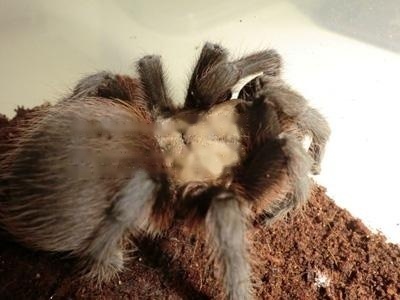
Texas Brown Tarantula
Adult body length is 13-14 cm, suitable temperature is 28-30 ℃, and suitable humidity is 65%. It is recommended to use moist peat, coconut brick and clay as the substrate. It tak
English name:Bolivian white knee Spider
Origin: Bolivia
Bolivian white-footedSpider (Latin name: Acanthoscurria insubtilis), also known as the Bolivian white-knee spider, is native to the Bolivian rainforest, and is a small species in the genus Acanthoscurria. The color and size are not outstanding. They are in Pets are naturally not very popular among tarantula lovers. The appearance of the adult individual is very close to the Costa Rican zebra feet.
The adult Bolivian white-footed spider has a foot span of 13-14 cm. Like other species of this genus, their larvae are also very small, and the newly hatched larvae have feet less than 1 cm. display, and burrows to hide. If a thicker substrate is provided, it will only take 1 or 2 days for it to adapt to the new environment, and it will be very difficult to see it again. However, after reaching a certain size, they no longer dig their own burrows as often, and are more willing to accept a ready-made shelter. The suitable temperature is 25-27°C, and the suitable humidity is 70%. It is recommended to use slightly damp peat blocks and coconut bricks as the substrate.
Chinese name: Bolivian white foot
Alternative name: Acanthoscurria insubtilis
Kingdom: Animalia
Subfamily: Theraphosinae
Origin: Bolivia
A small species in the genus Acanthoscurria, color Despite their size, they are naturally popular among pets tarantula lovers Not high either. The appearance of the adult individual is very close to the Costa Rican zebra feet.
Like other species of this genus, their larvae are also very small. The newly hatched larvae have a foot span of less than 1 cm and will burrow to hide. If a thicker substrate is provided, it will only take 1 or 2 days for it to adapt to the new environment, and it will be very difficult to see it again.
However, once they reach a certain size, they stop digging their own burrows as often and are more willing to accept a ready-made shelter.
Generally speaking, this is a type that is not very aggressive, and the degree of kicking is not too strong. It can be used as one of the types recommended for beginners.
However, they are relatively rare in the pet market, so their prices are not low. So, if you're looking to pursue a rare species, or to collect species of the genus Acanthoscurria, choose them.